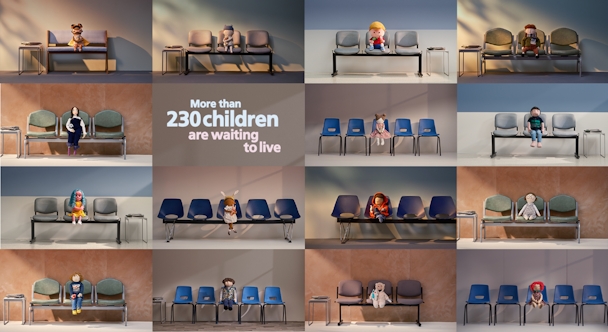Inside the NHS child organ donor drive
Winning Gold at The Drum Awards for PR in the best Integrated category is the NHS Blood and Transplant's Waiting to Live campaign by BCW. Here is the award-winning case study.

An example of the award-winning work / NHS Blood and Transplant
Objectives
In September 2023, ad exec Katie Tatham approached her colleagues to share her son’s diagnosis. Three-year-old Ralph had a rare form of cancer requiring him to get a multi-organ transplant (liver, pancreas and intestines) to survive.
Being moved by Ralph’s story, WPP employees quickly rallied troops and partnered with the National Health Service England (NHS) to help end the wait for Ralph and the other 232 children on the organ donation waiting list.
The campaign was crafted around the fact that there is currently a long waiting time for children to get an organ donation due to a national shortage in the UK. This is caused partly by sensitivity in broaching the subject, and the fact families need to proactively ‘opt-in’ to register their child for organ donation.
Want to go deeper? Ask The Drum
Brief
The agency BCW developed the Waiting to Live campaign to drive awareness about the UK organ donation system for those under 18 and highlight the reasons behind the long waiting times.
The optimal target group was parents with children so they could register their children to the National Health Service (NHS) England’s organ registry. To effectively engage parents to opt their child in for organ donations, there was only one way to do this; put a face to all 233 children on the waiting list.
The agency handcrafted 233 dolls that represented each child and told their story. Each doll was placed in NHS hospital waiting rooms across the UK, working closely with Ralph and his family to drum up media attention and for people to take note.
Advertisement
Each doll had a QR code, linking to the microsite ‘waitingtolive.org’ which hosts the children’s stories and links to the NHS organ register. Professional puppeteers supported the effort to ensure as close a likeness as possible to many children on the waiting list.
Then BCW conducted a national media outreach to general, consumer and trade outlets in two waves. One right before NHS Organ Donation Week in September and the second before Christmas, a time typically associated with children waiting to receive a Christmas gift, not a lifesaving organ.
Advertisement
For the first wave, the team prioritized PA media to ensure the release was distributed to as many outlets and to reach regional and local outlets. For the second, we offered exclusive interviews to a few select outlets, including Sky News, BBC, and Good Morning Britain. As some of the dolls were placed in regional hospitals, many local journalists also covered the story.
Other parts of the campaign included a microsite and an app, a soundtrack published on Spotify and campaign leaflets that were placed in over 30 hospital waiting rooms across the UK.
Suggested newsletters for you
Results
Two children, including Ralph, no longer have to wait, having received an organ transplant following the campaign launch. Over 1.5 billion people were reached via earned media, including top-tier publications such as BBC News, the Independent, Evening Standard, the Observer, the Daily Mail, the Daily Mirror, ITV News and Good Morning Britain.
There was a 10% uplift in opt-in registration to the NHS donor list in the under-18 demographic and an 18% reduction in opt-outs in the same demographic. There was a 115% rise in website visits in September and over 30,000 visits to the microsite (waitingtolive.org) from November to December with each person visiting the site watching two to three stories on average from the featured children. The QR codes on dolls placed in waiting rooms were scanned on average 20-30 times per day
Overall the campaign achieved £14.6m in earned media value.
Ready to get your work recognized on a global stage? Enter The Drum Awards today. Need more inspiration, read our Award Winning Case Studies.
